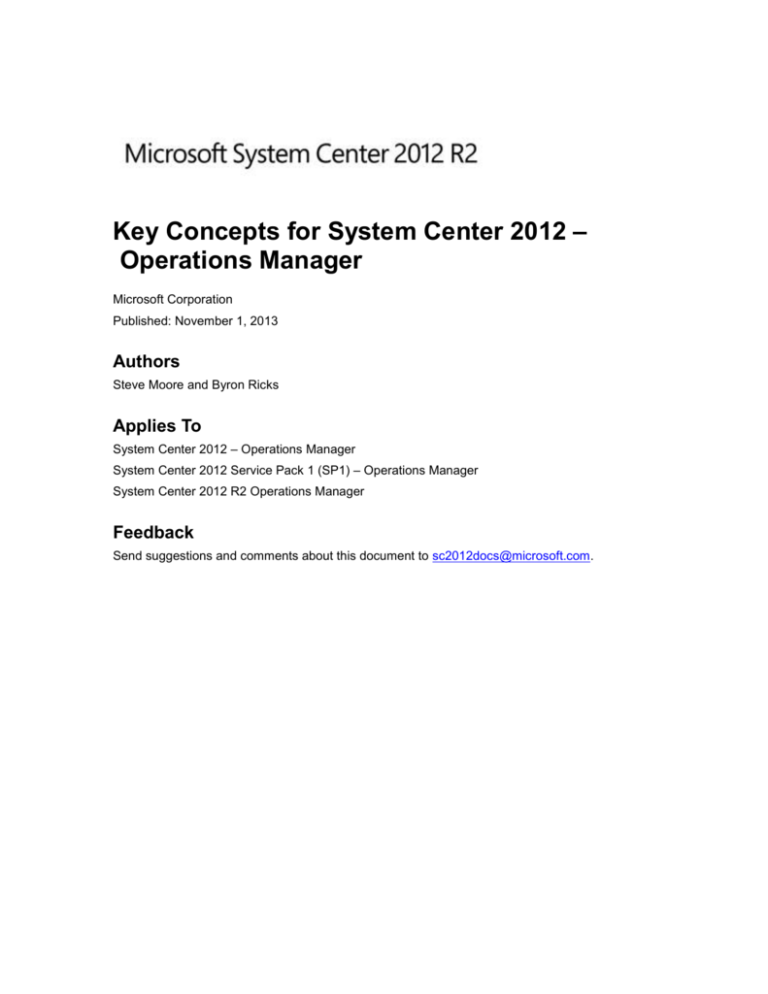
Key Concepts for System Center 2012 –
Operations Manager
Microsoft Corporation
Published: November 1, 2013
Authors
Steve Moore and Byron Ricks
Applies To
System Center 2012 – Operations Manager
System Center 2012 Service Pack 1 (SP1) – Operations Manager
System Center 2012 R2 Operations Manager
Feedback
Send suggestions and comments about this document to sc2012docs@microsoft.com.
Copyright
This document is provided "as-is". Information and views expressed in this document, including
URL and other Internet website references, may change without notice.
Some examples depicted herein are provided for illustration only and are fictitious. No real
association or connection is intended or should be inferred.
This document does not provide you with any legal rights to any intellectual property in any
Microsoft product. You may copy and use this document for your internal, reference purposes.
You may modify this document for your internal, reference purposes.
© 2013 Microsoft Corporation. All rights reserved.
Microsoft, Active Directory, Bing, Internet Explorer, JScript, SharePoint, Silverlight, SQL Server,
Visio, Visual Basic, Visual Studio, Win32, Windows, Windows Intune, Windows PowerShell, and
Windows Vista are trademarks of the Microsoft group of companies. Portions of this
documentation related to network monitoring are provided by EMC, and for those portions the
following copyright notice applies 2010 © EMC Corporation. All rights reserved. All other
trademarks are property of their respective owners.
Revision History
Release Date
Changes
October 17, 2013
Original release of this guide.
November 1, 2013
Minor updates for this guide.
Contents
Operations Manager Key Concepts ................................................................................................ 4
Operations Manager Key Concepts
Operations Manager, a component of Microsoft System Center 2012, is software that helps you
monitor services, devices, and operations for many computers from a single console. This topic
explains basic concepts about Operations Manager for the administrator who manages the
Operations Manager infrastructure and the operator who monitors and supports the computers in
your business.
What Operations Manager Does
Businesses, small and large, are typically dependent on the services and applications provided
by their computing environment. IT departments are responsible for ensuring the performance
and availability of those critical services and applications. That means that IT departments need
to know when there is a problem, identify where the problem is, and figure out what is causing the
problem, ideally before the users of the applications encounter the problems. The more
computers and devices in the business, the more challenging this task becomes.
Using Operations Manager in the environment makes it easier to monitor multiple computers,
devices, services, and applications. The Operations console, shown in the following image,
enables you to check the health, performance, and availability for all monitored objects in the
environment and helps you identify and resolve problems.
4
Note
To learn how to use the Operations Manager consoles, see Using the Operations
Manager Consoles in the Operations Guide.
Operations Manager will tell you which monitored objects are not healthy, send alerts when
problems are identified, and provide information to help you identify the cause of a problem and
possible solutions. As the administrator, you configure what will be monitored by selecting
computers and devices to be monitored and importing management packs that provide
monitoring for specific features and applications. To decide which objects to monitor and what to
monitor for, you need to understand the features that comprise the Operations Manager
infrastructure and how Operations Manager works.
The Operations Manager Infrastructure
Installing Operations Manager creates a management group. The management group is the basic
unit of functionality. At a minimum, a management group consists of a management server, the
operational database, and the reporting data warehouse database.
5
The management server is the focal point for administering the management group and
communicating with the database. When you open the Operations console and connect to a
management group, you connect to a management server for that management group.
Depending on the size of your computing environment, a management group can contain a
single management server or multiple management servers.
The operational database is a SQL Server database that contains all configuration data for
the management group and stores all monitoring data that is collected and processed for the
management group. The operational database retains short-term data, by default 7 days.
The data warehouse database is a SQL Server database that stores monitoring and alerting
data for historical purposes. Data that is written to the Operations Manager database is also
written to the data warehouse database, so reports always contain current data. The data
warehouse database retains long-term data.
When Operations Manager reporting functionality is installed, the management group also
contains a Reporting server which builds and presents reports from data in the data warehouse
database.
These core components of a management group can exist on a single server, or they can be
distributed across multiple servers, as shown in the following image.
For information about installing management group features, see Operations Manager 2012
Deployment Guide.
Management Servers
The role of the management server is to administer the management group configuration,
administer and communicate with agents, and communicate with the databases in the
management group.
The management group can contain multiple management servers to provide additional capacity
and continuous availability. When two or more management servers are added to a management
group, the management servers become part of a resource pool and work is spread across the
members of the pool. When a member of the resource pool fails, other members in the resource
pool will pick up that member’s workload. When a new management server is added, the new
management server automatically picks up some of the work from existing members in the
6
resource pool. All members in the resource pool will manage a distinct set of remote objects; at
any given time, two members in the same pool will not manage the same object at the same time.
A specialized type of management server is the gateway server. A gateway server enables the
monitoring of computers in untrusted domains. For more information, see Monitoring Across
Untrusted Boundaries.
Agents
An Operations Manager agent is a service that is installed on a computer. The agent collects
data, compares sampled data to predefined values, creates alerts, and runs responses. A
management server receives and distributes configurations to agents on monitored computers.
Every agent reports to a management server in the management group. This management server
is referred to as the agent's primary management server.
Agents watch data sources on the monitored computer and collect information according to the
configuration that is sent to it from its management server. The agent also calculates the health
state of the monitored computer and objects on the monitored computer and reports back to the
management server. When the health state of a monitored object changes or other criteria are
met, an alert can be generated from the agent. This lets operators know that something requires
attention. By providing health data about the monitored object to the management server, the
agent provides an up-to-date picture of the health of the device and all the applications that it
hosts.
An agent can be configured to act as a proxy agent. A proxy agent is an agent that can forward
data to a management server on behalf of a computer or network device other than its host
computer. For example, an agent that is installed on the physical node of an SQL cluster can be
enabled to act as proxy to monitor the cluster resource. Proxy agents enable monitoring of
computers and devices on which an agent cannot be installed. For more information, see
Agentless Monitoring.
Services
On a monitored computer, the Operations Manager agent is listed as the System Center
Management Health service. The System Center Management Health service collects
performance data, executes tasks, and so on. Even when the service is unable to communicate
with the management server it reports to, the service continues to run and queues the collected
data and events on the disk of the monitored computer. When the connection is restored, the
System Center Management Health service sends collected data and events to the management
server.
Note
The System Center Management Health service is sometimes referred to as the health
service.
The System Center Management Health service also runs on management servers. On a
management server, the System Center Management Health service runs monitoring workflows
7
and manages credentials. To run workflows, the System Center Management Health service
initiates MonitoringHost.exe processes using specified credentials. These processes monitor and
collect event log data, performance counter data, Windows Management Instrumentation (WMI)
data, and run actions such as scripts.
Management servers also run the System Center Data Access service and the System Center
Management Configuration service.
The System Center Data Access service provides access for the Operations console to the
operational database and writes data to the database.
The System Center Management Configuration service manages the relationships and topology
of the management group. It also distributes management packs to monitored objects.
Management Packs
The workflows that the System Center Management service runs are defined by management
packs. Management packs define the information that the agent collects and returns to the
management server for a specific application or technology. For example, the BizTalk Server
Management Pack contains rules and monitors that collect and evaluate events and operations
that are important to ensuring the health and efficiency of the BizTalk Server application.
After Operations Manager installs an agent on a computer, it sends an initial configuration to the
agent. The initial configuration includes object discoveries from management packs. The
management pack defines the types of objects, such as applications and features, that will be
monitored on computers that have been discovered by Operations Manager. Agents send data to
the management server that identifies the instances of objects discovered on the computer. The
management server then sends the agents the elements of management packs that apply to the
discovered objects for each computer, such as rules and monitors.
A rule defines the events and performance data to collect from computers and what to do with the
information after it is collected. A simple way to think about rules is as an If/Then statement. For
example, a management pack for an application might contain rules such as the following:
If a message indicating that the application is shutting down appears in the event log, create
an alert.
If upload of a source file fails, collect the event that indicates this failure.
As these examples show, rules can create alerts and collect events or performance data, which
the agent sends to the management server. Rules can also run scripts, such as allowing a rule to
attempt to restart a failed application.
Discovered objects have a health state, which is reflected in the Operations console as green
(successful or healthy), yellow (warning), or red (critical or unhealthy). Monitors define the health
states for particular aspects of the monitored object. For example, a monitor for disk drive
capacity might define green as less than 85 percent full, yellow as over 85 percent full, and red as
over 90 percent full. A monitor can be configured to generate an alert when a state change
occurs.
8
How Objects Are Discovered and Monitored
The following image is a simplified illustration of how objects are discovered and monitored.
1. The administrator configures Operations Manager to search for computers to manage. For
more information about discovering computers, see Managing Discovery and Agents.
2. Computers that meet the specified criteria and are not already managed are identified.
3. An Operations Manager agent is installed on the discovered computer.
4. The agent requests configuration data, and then the management server sends the agent
configuration data from installed management packs that includes classes to be discovered.
For example, if the Windows Server operating system management packs are installed, the
management server will send the agent the operating system classes.
5. The agent compares the configuration data to the computer, identifies any objects that it
discovers, and returns the information to the management server. For example, the agent will
return to the management server that an instance of Windows Server 2008 R2 operating
system is on the computer.
6. The management server sends the agent all monitoring logic from installed management
packs that applies to the discovered objects. For example, the agent will receive all
monitoring logic that applies to Windows Server 2008 R2.
7. The agent applies the monitoring logic, such as rules and monitors, runs workflows, and
returns data to the management server.
8. As changes occur to discovered objects, such as applications being added or uninstalled, the
agent sends the updated information to the management server, which then sends updated
monitoring logic.
Note
9
Operations Manager can also discover and monitor network devices, computers running
UNIX and Linux operating systems, and provide agentless monitoring. For more
information, see Operations Manager Monitoring Scenarios in the Operations Guide.
Communication Between Agents and Management Servers
The Operations Manager agent sends alert and discovery data to the primary management
server, which writes the data to the operational database. The agent also sends events,
performance, and state data to the primary management server for that agent, which writes the
data to the operational and data warehouse databases simultaneously.
The agent sends data according to the schedule parameters for each rule and monitor. For
optimized collection rules, data is only transmitted if a sample of a counter differs from the
previous sample by a specified tolerance, such as 10%. This helps reduce network traffic and the
volume of data stored in the operational database.
Additionally, all agents send a packet of data, called a heartbeat, to the management server on a
regular schedule, by default every 60 seconds. The purpose of the heartbeat is to validate the
availability of the agent and communication between the agent and the management server. For
more information on heartbeats, see How Heartbeats Work in Operations Manager.
For each agent, Operations Manager runs a health service watcher, which monitors the state of
the remote Health Service from the perspective of the management server.
Other resources for Operations Manager
TechNet Library main page for Operations Manager
To learn how to install Operations Manager and deploy a management group, see
Deployment Guide for Operations Manager for System Center 2012
To learn how to use Operations Manager after the management group is set up, see
Operations Guide for Operations Manager for System Center 2012
To learn how to create a management pack, see Author’s Guide for Operations Manager for
System Center 2012
Operations Manager Documentation Downloads
Operations Manager Community
10







